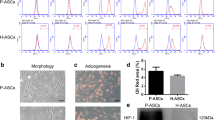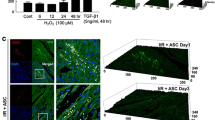Abstract
Background
Adipose-derived stem cells (ADSCs) have become a promising tool for a wide range of cell-based therapies. However, transplanted ADSCs do not survive well under ischemic conditions. In this study we aimed to inhibit oxygen-glucose deprivation (OGD)-induced apoptosis of human ADSCs by genetic modification with antiapoptotic protein Bcl-2.
Methods
After isolation and culture, the phenotypes of human ADSCs at passage 3 were analyzed by flow cytometry. Then, genetic modification of ADSCs with Bcl-2 was carried out. Bcl-2 gene transfection was verified by Western blot analysis and multipotent differentiation properties were evaluated in Bcl-2-modified ADSCs (Bcl-2-ADSCs). Apoptosis was evaluated by a TUNEL assay under ischemic conditions induced by OGD. Apoptotic nuclei were also assessed and quantified by Hoechst staining.
Results
The cultured ADSCs expressed stem cell-associated markers CD29, CD34, CD44, and CD90, but not fibroblast marker HLA-DR or hematopoietic stem cell marker CD133. The Bcl-2 gene was transferred into ADSCs efficiently, and Bcl-2-ADSCs differentiated into adipocytes, chondrocytes, and osteoblasts. In addition, Bcl-2 overexpression reduced the percentage of apoptotic Bcl-2-ADSCs by 38 % under OGD.
Conclusion
Our results indicate that Bcl-2 overexpression through gene transfection inhibits apoptosis of ADSCs under ischemic conditions.
No Level Assigned
This journal requires that authors assign a level of evidence to each submission to which Evidence-Based Medicine rankings are applicable. This excludes Review Articles, Book Reviews, and manuscripts that concern Basic Science, Animal Studies, Cadaver Studies, and Experimental Studies. For a full description of these Evidence-Based Medicine ratings, please refer to the Table of Contents or the online Instructions to Authors www.springer.com/00266.




Similar content being viewed by others
References
Zuk PA, Zhu M, Mizuno H, Huang J, Futrell JW, Katz AJ, Benhaim P, Lorenz HP, Hedrick MH (2001) Multilineage cells from human adipose tissue: implications for cell-based therapies. Tissue Eng 7:211–228
Gimble JM, Katz AJ, Bunnell BA (2007) Adipose-derived stem cells for regenerative medicine. Circ Res 100:1249–1260
Yoshimura H, Muneta T, Nimura A, Yokoyama A, Koga H, Sekiya I (2007) Comparison of rat mesenchymal stem cells derived from bone marrow, synovium, periosteum, adipose tissue, and muscle. Cell Tissue Res 327:449–462
Lin Y, Chen X, Yan Z, Liu L, Tang W, Zheng X, Li Z, Qiao J, Li S, Tian W (2006) Multilineage differentiation of adipose-derived stromal cells from GFP transgenic mice. Mol Cell Biochem 285:69–78
Romanov YA, Darevskaya AN, Merzlikina NV, Buravkova LB (2005) Mesenchymal stem cells from human bone marrow and adipose tissue: isolation, characterization, and differentiation potentialities. Bull Exp Biol Med 140:138–143
Planat-Benard V, Silvestre JS, Cousin B, André M, Nibbelink M, Tamarat R, Clergue M, Manneville C, Saillan-Barreau C, Duriez M, Tedgui A, Levy B, Pénicaud L, Casteilla L (2004) Plasticity of human adipose lineage cells toward endothelial cells: physiological and therapeutic perspectives. Circulation 109:656–663
Matsumoto D, Sato K, Gonda K, Takaki Y, Shigeura T, Sato T, Aiba-Kojima E, Iizuka F, Inoue K, Suga H, Yoshimura K (2006) Cell-assisted lipotransfer: supportive use of human adipose-derived cells for soft tissue augmentation with lipoinjection. Tissue Eng 12:3375–3382
Yoshimura K, Sato K, Aoi N, Kurita M, Hirohi T, Harii K (2008) Cell-assisted lipotransfer for cosmetic breast augmentation: supportive use of adipose-derived stem/stromal cells. Aesthet Plast Surg 32:48–55
Lendeckel S, Jödicke A, Christophis P, Heidinger K, Wolff J, Fraser JK, Hedrick MH, Berthold L, Howaldt HP (2004) Autologous stem cells (adipose) and fibrin glue used to treat widespread traumatic calvarial defects: case report. J Craniomaxillofac Surg 32:370–373
Nie C, Yang D, Xu J, Si Z, Jin X, Zhang J (2011) Locally administered adipose-derived stem cells accelerate wound healing through differentiation and vasculogenesis. Cell Transpl 20:205–216
Léobon B, Roncalli J, Joffre C, Mazo M, Boisson M, Barreau C, Calise D, Arnaud E, André M, Pucéat M, Pénicaud L, Prosper F, Planat-Bénard V, Casteilla L (2009) Adipose-derived cardiomyogenic cells: in vitro expansion and functional improvement in a mouse model of myocardial infarction. Cardiovasc Res 83:757–767
Toma C, Pittenger MF, Cahill KS, Byrne BJ, Kessler PD (2002) Human mesenchymal stem cells differentiate to a cardiomyocyte phenotype in the adult murine heart. Circulation 105:93–98
Pittenger MF, Martin BJ (2004) Mesenchymal stem cells and their potential as cardiac therapeutics. Circ Res 95:9–20
Luo H, Zhang Y, Zhang Z, Jin Y (2012) The protection of MSCs from apoptosis in nerve regeneration by TGFbeta1 through reducing inflammation and promoting VEGF-dependent angiogenesis. Biomaterials 33:4277–4287
Tsujimoto Y, Cossman J, Jaffe E, Croce CM (1985) Involvement of the bcl-2 gene in human follicular lymphoma. Science 228:1440–1443
Akao Y, Otsuki Y, Kataoka S, Ito Y, Tsujimoto Y (1994) Multiple subcellular localization of bcl-2: detection in nuclear outer membrane, endoplasmic reticulum membrane, and mitochondrial membranes. Cancer Res 54:2468–2471
Krajewski S, Tanaka S, Takayama S, Schibler MJ, Fenton W, Reed JC (1993) Investigation of the subcellular distribution of the bcl-2 oncoprotein: residence in the nuclear envelope, endoplasmic reticulum, and outer mitochondrial membranes. Cancer Res 53:4701–4714
Reed JC (1998) Bcl-2 family proteins. Oncogene 17:3225–3236
Li J, Qu Y, Chen D, Zhang L, Zhao F, Luo L, Pan L, Hua J, Mu D (2013) The neuroprotective role and mechanisms of TERT in neurons with oxygen-glucose deprivation. Neuroscience 252:346–358
Planat-Bénard V, Menard C, André M, Puceat M, Perez A, Garcia-Verdugo JM, Pénicaud L, Casteilla L (2004) Spontaneous cardiomyocyte differentiation from adipose tissue stroma cells. Circ Res 94:223–229
Yoshimura K, Eto H, Kato H, Doi K, Aoi N (2011) In vivo manipulation of stem cells for adipose tissue repair/reconstruction. Regen Med 6:33–41
Eirin A, Zhu XY, Krier JD, Tang H, Jordan KL, Grande JP, Lerman A, Textor SC, Lerman LO (2012) Adipose tissue-derived mesenchymal stem cells improve revascularization outcomes to restore renal function in swine atherosclerotic renal artery stenosis. Stem Cells 30:1030–1041
Zhang M, Methot D, Poppa V, Fujio Y, Walsh K, Murry CE (2001) Cardiomyocyte grafting for cardiac repair: graft cell death and anti-death strategies. J Mol Cell Cardiol 33:907–921
Cheng Z, Ou L, Zhou X, Li F, Jia X, Zhang Y, Liu X, Li Y, Ward CA, Melo LG, Kong D (2008) Targeted migration of mesenchymal stem cells modified with CXCR4 gene to infarcted myocardium improves cardiac performance. Mol Ther 16:571–579
Borden BA, Yockman J, Kim SW (2010) Thermoresponsive hydrogel as a delivery scaffold for transfected rat mesenchymal stem cells. Mol Pharm 7:963–968
Kirshenbaum LA, de Moissac D (1997) The bcl-2 gene product prevents programmed cell death of ventricular myocytes. Circulation 96:1580–1585
Murphy AN, Bredesen DE, Cortopassi G, Wang E, Fiskum G (1996) Bcl-2 potentiates the maximal calcium uptake capacity of neural cell mitochondria. Proc Natl Acad Sci U S A 93:9893–9898
Nuñez G, London L, Hockenbery D, Alexander M, McKearn JP, Korsmeyer SJ (1990) Deregulated Bcl-2 gene expression selectively prolongs survival of growth factor-deprived hemopoietic cell lines. J Immunol 144:3602–3610
Veis DJ, Sorenson CM, Shutter JR, Korsmeyer SJ (1993) Bcl-2-deficient mice demonstrate fulminant lymphoid apoptosis, polycystic kidneys, and hypopigmented hair. Cell 75:229–240
Shelat PB, Plant LD, Wang JC, Lee E, Marks JD (2013) The membrane-active tri-block copolymer pluronic F-68 profoundly rescues rat hippocampal neurons from oxygen-glucose deprivation-induced death through early inhibition of apoptosis. J Neurosci 33:12287–12299
Zhao J, Qu Y, Wu J, Cao M, Ferriero DM, Zhang L, Mu D (2013) PTEN inhibition prevents rat cortical neuron injury after hypoxia-ischemia. Neuroscience 238:242–251
Lapergue B, Dang BQ, Desilles JP, Ortiz-Munoz G, Delbosc S, Loyau S, Louedec L, Couraud PO, Mazighi M, Michel JB, Meilhac O, Amarenco P (2013) High-density lipoprotein-based therapy reduces the hemorrhagic complications associated with tissue plasminogen activator treatment in experimental stroke. Stroke 44:699–707
Gronthos S, Franklin DM, Leddy HA, Robey PG, Storms RW, Gimble JM (2001) Surface protein characterization of human adipose tissue-derived stromal cells. Cell Physiol 189:54–63
Yoshimura K, Shigeura T, Matsumoto D, Sato T, Takaki Y, Aiba-Kojima E, Sato K, Inoue K, Nagase T, Koshima I, Gonda K (2006) Characterization of freshly isolated and cultured cells derived from the fatty and fluid portions of liposuction aspirates. Cell Physiol 208:64–76
Mizuno H, Tobita M, Uysal AC (2012) Concise review: adipose-derived stem cells as a novel tool for future regenerative medicine. Stem Cells 30:804–810
Rehman J, Traktuev D, Li J, Merfeld-Clauss S, Temm-Grove CJ, Bovenkerk JE, Pell CL, Johnstone BH, Considine RV, March KL (2004) Secretion of angiogenic and antiapoptotic factors by human adipose stromal cells. Circulation 109:1292–1298
Simons M, Annex BH, Laham RJ, Kleiman N, Henry T, Dauerman H, Udelson JE, Gervino EV, Pike M, Whitehouse MJ, Moon T, Chronos NA (2002) Pharmacological treatment of coronary artery disease with recombinant fibroblast growth factor-2: double-blind, randomized, controlled clinical trial. Circulation 105:788–793
Henry TD, Annex BH, McKendall GR, Azrin MA, Lopez JJ, Giordano FJ, Shah PK, Willerson JT, Benza RL, Berman DS, Gibson CM, Bajamonde A, Rundle AC, Fine J, McCluskey ER, VIVA Investigators (2003) The VIVA trial: vascular endothelial growth factor in Ischemia for vascular angiogenesis. Circulation 107:1359–1365
Razmkhah M, Jaberipour M, Ghaderi A (2011) Bcl-2 and Fas expressions correlate with proliferative specificity of adipose-derived stem cells (ASCs) in breast cancer. Immunol Invest 40:290–298
Osford SM, Dallman CL, Johnson PW, Ganesan A, Packham G (2004) Current strategies to target the anti-apoptotic Bcl-2 protein in cancer cells. Curr Med Chem 11:1031–1039
Hitt MM, Addison CL, Graham FL (1997) Human adenovirus vectors for gene transfer into mammalian cells. Adv Pharmacol 40:137–206
Zhang S, Xu G, Liu C, Xiao S, Sun Y, Su X, Cai Y, Li D, Xu B (2005) Clinical study of recombinant adenovirus-p53 (Adp53) combined with hyperthermia in advanced cancer (a report of 15 cases). Int J Hyperth 21:631–636
Pan JJ, Zhang SW, Chen CB, Xiao SW, Sun Y, Liu CQ, Su X, Li DM, Xu G, Xu B, Lu YY (2009) Effect of recombinant adenovirus-p53 combined with radiotherapy on long-term prognosis of advanced nasopharyngeal carcinoma. J Clin Oncol 27:799–804
Li X, Xiao S, Li Y, Zhang S (2013) Clinical antiangiogenic effect of recombinant adenovirus-p53 combined with hyperthermia for advanced cancer. Chin J Cancer Res 25:749–755
Acknowledgments
This work was supported by grants from the National Natural Science Foundation of China (81272108), the Key Talent Foundation of China (RC2007009), and the 333 Project Talent Foundation of China (NJGL2007116).
Conflicts of interest
The authors have no conflicts of interest or financial ties to declare.
Author information
Authors and Affiliations
Corresponding author
Rights and permissions
About this article
Cite this article
Cui, Z., Shen, L., Lin, Y. et al. Inhibition of Oxygen-Glucose Deprivation-Induced Apoptosis of Human Adipose-Derived Stem Cells by Genetic Modification with Antiapoptotic Protein Bcl-2. Aesth Plast Surg 38, 779–787 (2014). https://doi.org/10.1007/s00266-014-0354-y
Received:
Accepted:
Published:
Issue Date:
DOI: https://doi.org/10.1007/s00266-014-0354-y




